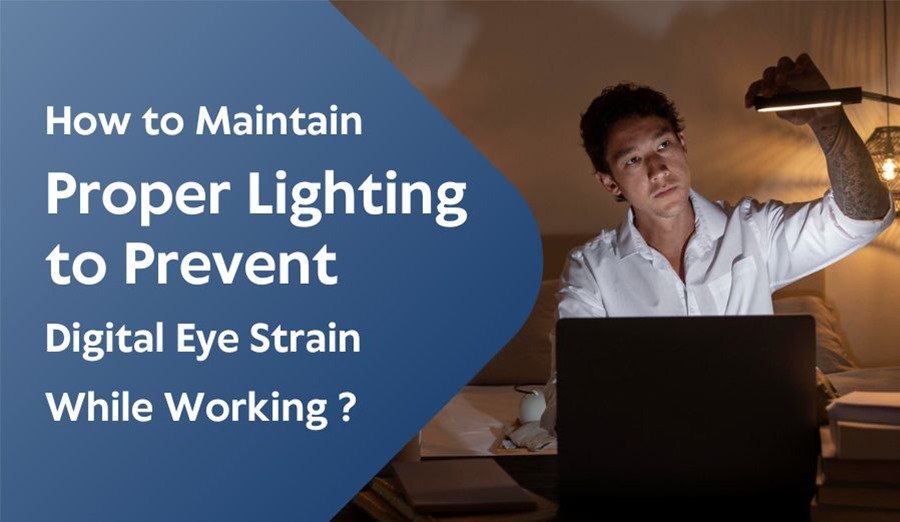Hello reader!
Welcome to the blog page of Pushpanjali, one of the best eye hospitals in Kolkata. In this blog, we will share with you some of the ways to maintain proper lighting to prevent digital eye strain.
In today’s digital age, where screens dominate our work and leisure time, it’s crucial to pay attention to lighting conditions to protect our eyes from digital eye strain. As one of the best eye hospitals in Kolkata, Pushpanjali Eye Care emphasizes the importance of proper lighting for eye health. Here’s a comprehensive guide on how to maintain optimal lighting to prevent digital eye strain:
1. Adjust Ambient Lighting:
Adjusting Ambient Lighting to Reduce Eye Strain:
Proper ambient lighting is essential for maintaining eye health, especially in environments where digital screens are extensively used. Here are some effective strategies:
- Utilize Natural Light: Position your workstation near windows to maximize exposure to natural light. Natural light not only enhances visibility but also helps reduce glare on screens. It provides a balanced spectrum of light that is soothing and minimizes eye strain. Ensuring that the light does not directly hit the screen helps in maintaining comfort during prolonged use.
- Optimize Artificial Lighting: Artificial lighting should complement natural light to create an optimal working environment:
- Adjustable Fixtures: Use lighting fixtures with adjustable settings to control brightness levels. This allows you to customize the lighting based on your tasks and preferences.
- Avoid Harsh Overhead Lighting: Harsh overhead lighting can cause glare and discomfort. Instead, opt for indirect or diffused lighting options that distribute light evenly across the workspace.
- Choose the Right Bulbs: Select bulbs that mimic natural daylight, typically in the range of 5000 to 6500 Kelvin. These bulbs provide a color temperature that closely resembles natural sunlight, which is easier on the eyes and helps in reducing eye strain.
2. Minimizing Glare and Reflections:
To protect your eyes from discomfort and strain, it is crucial to address glare and reflections from light sources. Here are detailed strategies to help you achieve this:
Optimal Screen Positioning:
- Perpendicular Placement: Position your computer screen perpendicular to windows to take advantage of natural light without causing direct reflections. This placement helps in diffusing the light evenly, reducing the intensity of glare.
- Avoid Direct Light Sources: Refrain from positioning your screen directly in front of or behind light sources, such as windows or bright lamps. Direct light can create harsh reflections and glare on your screen, leading to eye strain and discomfort. Instead, choose a location where light comes from the side, providing indirect illumination.
Use of Anti-Glare Filters:
- Screen Protection: Invest in anti-glare filters for your computer screens and other digital devices. These filters are designed to reduce reflections and glare, making it easier on your eyes during prolonged screen use.
- Enhanced Comfort: Anti-glare filters work by diffusing the light that hits your screen, minimizing the sharpness of reflections. This not only reduces eye strain but also enhances overall visual comfort, allowing you to work for extended periods without discomfort.
3. Optimize Screen Settings:
Brightness and Contrast:
- Adjust for Comfort: Ensure that the brightness and contrast settings of your screen are adjusted to levels that are comfortable for your eyes. The screen should neither be excessively bright nor too dim. A screen that is too bright in a dark room or too dark in a bright room can cause significant eye strain.
- Environment Matching: Match your screen brightness with the ambient lighting of your environment. For example, in a brightly lit room, increase your screen brightness. Conversely, in a dimly lit room, reduce the screen brightness to avoid harsh contrast that can strain your eyes.
Font Size and Color:
- Larger Font Sizes: Opt for larger font sizes to reduce the need for squinting and leaning forward to read text on the screen. This adjustment can help maintain a comfortable viewing distance and posture, reducing overall eye strain.
- High-Contrast Color Schemes: Choose high-contrast color schemes for your screen settings to enhance readability. The most effective combination is black text on a white background. This contrast makes the text stand out more clearly, reducing the effort your eyes need to focus on the screen content.
- Customization Options: Take advantage of the customization options available in your operating system or applications to further tailor font sizes and color schemes to your preference. Many systems offer accessibility settings designed to enhance visual comfort.
4. Take Regular Breaks:
- Follow the 20-20-20 rule: Every 20 minutes, look at something 20 feet away for at least 20 seconds. This practice helps reduce eye fatigue caused by continuous screen use.
5. Use Task Lighting:
- Supplement ambient lighting with task lighting directed onto your work area. Desk lamps with adjustable arms and brightness settings can provide focused light without straining your eyes.
6. Consider Ergonomics:
- Ensure your workstation setup promotes good posture and reduces strain on your neck and shoulders. Proper ergonomics can indirectly reduce eye strain by promoting overall comfort.
FAQ
- What is the best type of lighting to use while working on a computer to reduce eye strain?
To reduce eye strain while working on a computer, it is best to use a combination of natural and artificial lighting. Natural light is optimal, so position your workstation near windows to take advantage of it. For artificial lighting, use adjustable fixtures with bulbs that mimic natural daylight (5000-6500 Kelvin) to provide a balanced light spectrum that reduces eye fatigue.
- How should I position my computer screen to minimize glare and reflections?
To minimize glare and reflections, position your computer screen perpendicular to windows and other light sources. Avoid placing the screen directly in front of or behind light sources, as this can create harsh reflections and glare. This positioning helps in diffusing the light evenly and reduces the intensity of reflections that can cause eye strain.
- Are there any specific types of bulbs I should use to create a comfortable working environment?
Yes, use bulbs that mimic natural daylight with a color temperature of 5000-6500 Kelvin. These daylight-mimicking bulbs provide a balanced light spectrum that is gentle on the eyes and helps reduce eye strain. Avoid using overly bright or harsh overhead lighting, and consider using adjustable lighting fixtures to control brightness levels effectively.
- How can I adjust my screen settings to further reduce digital eye strain?
To reduce digital eye strain, adjust your screen settings as follows:
- Brightness and Contrast: Set your screen brightness and contrast to levels that match the ambient lighting of your workspace. Avoid having your screen too bright in a dark room or too dim in a bright room.
- Font Size and Color: Choose larger font sizes and high-contrast color schemes (e.g., black text on a white background) to enhance readability and reduce the effort needed to focus on the screen content.
- What are some additional tips to prevent digital eye strain while working?
In addition to optimizing lighting and screen settings, follow these tips to prevent digital eye strain:
- Take Regular Breaks: Follow the 20-20-20 rule: every 20 minutes, look at something 20 feet away for at least 20 seconds to reduce eye fatigue.
- Use Anti-Glare Filters: Consider using anti-glare filters on your screens to reduce reflections and glare.
- Ergonomic Setup: Ensure your workstation is ergonomically set up to promote good posture and overall comfort, indirectly reducing eye strain.
Conclusion
Proper lighting is crucial in preventing digital eye strain and maintaining overall eye health. By implementing these tips, you can create a workspace that promotes comfortable and efficient screen use while reducing the risk of eye discomfort. For personalized eye care and expert advice, visit Pushpanjali Eye Care, a trusted eye hospital in Kolkata committed to providing comprehensive eye care services.
Remember, your eyes deserve the best care, and maintaining proper lighting is a step toward a healthier vision in the digital era.
For more information or to book an appointment, contact Pushpanjali Eye Care, one of the best eye hospitals in Kolkata.




